February 5, 2023
Wedding Planning Tip: Small Wedding or a Large Wedding?
There is a long list of things to consider as you begin wedding planning. You start with the time of year, a general location, and a type of venue. Among the first of those major decisions is the guest list! Determining what type of wedding you would like – a small wedding or a large wedding – will guide a number of decisions you make as you kick off planning and along the process. Once you tackle this most daunting of tasks is when you truly determine what size wedding is right for you.
Over our near decade-and-a-half of weddings, we’ve celebrated events with eight guests, all the way up to 422 guests and every number in between. As trends, the economy, and priorities progress across generations, we see the same as far as guest counts. As a couple, you’ll find the answer to this question is necessary as you consider a long list of factors.
Let’s Talk About the Wedding Guest Count…
Besides the date and location, the guest list is the next piece of information vendors and venues request. As you get started, you’ll see this is really deciding factor No. 1 as it drives where you look and how your budget takes shape. This is important to keep in mind throughout planning, too.
Though there are several helpful budget tools available online, there are also just as many factors to consider when building your own, and one size does not fit all. We’ll share more tips on crafting your budget soon, but there are two sentiments to keep in mind. There will be aspects of your budget that are based on time, while the rest is based on your guest count. Things that are influenced by your guest count include food and beverage, rentals, flower costs, transportation, stationery, favors, and hotel welcome bags to start. More guests equal higher costs.
If you’re on Instagram, one of the newest platforms I’ve been closely following is Maroo Wedding. They’ve been featuring real wedding budgets from several different states, guest counts, venues, and more. It’s important to remember that no two weddings or budgets are the same, as these are dependent on a variety of details discussed above.
What’s the Difference Between a Small Wedding & a Large Wedding?
Where do we draw the line between a small wedding and a large wedding? For us, small weddings are around 50 guests are less. The large weddings are about 175 and above. As you can see, there is a large gap here, and we like to label those the more “average” weddings. As you initiate planning, you’ll commonly find 150 guests set as the minimum or as the venue’s recommended capacity.
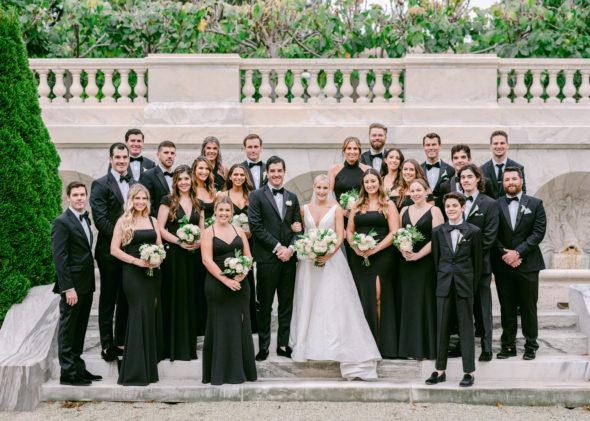
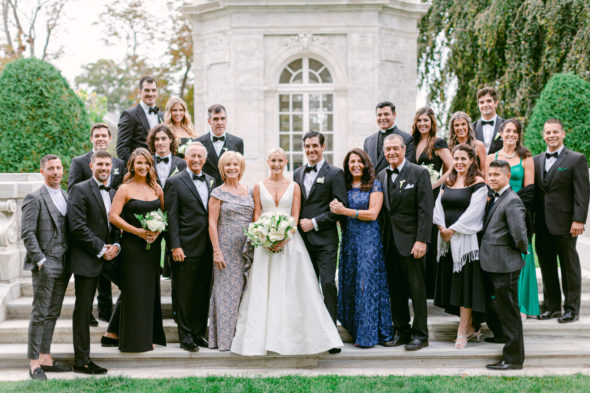
Photos by Melissa Stimpson Photography
We’ve compiled a list of considerations for your guest count to help you determine what would be the best fit for your wedding weekend!
Considerations for a Small Wedding
Venue Options – Having a smaller guest count allows more flexibility with your venue options and gives couples the opportunity to take advantage of more unique spaces. While not new, small weddings aren’t as expected as larger weddings, so many locations are best suited for larger counts. To avoid dead space within a venue, couples can have more fun with their decor team creating distinct spaces for the various moments of their day.
Create an Intentional Budget – Fewer guests certainly allow for a smaller overall budget; however, what it truly allows for is allotting funds towards decor and the overall experience. In other words, you can more freely spend money on the items you would like to invest in.
When it comes to budget, minimizing doesn’t equate in an apples-to-apples way. Remember: there are areas that are determined by your guest count and then those that are set by the amount of time a vendor is onsite. These elements consider the venue, photography, videography, entertainment, and even transportation again.
Spend More on the Experience – As we alluded to above, a smaller wedding means costs are dedicated less to areas controlled by the guest count. This allows costs to go to the overall experience, which plays a large role in the impact guests receive. We accomplish this in a few ways with our couples.
First, we allot more to the design – flowers, unique stationery, and customized rentals that allow your day to stand out. You are able to personalize everything, from monogrammed napkins to your own fashion, which lasts far past the wedding day. My favorite area to invest in are the amenities. We love building welcome gifts for our guests, full of all the necessities needed for a long week. These can include emergency kits after a night of partying, local snacks, and even gifts at your welcome party or wedding day that guests can have fit just for them.
One of our favorite and most memorable small weddings allowed us to build a space almost entirely out of flowers, transitioning the dining room into a garden oasis. Flowers spilled over the edges of seats and blanketed the entryways of the room. Guests were in awe and are still talking to this day about what a beautiful celebration it was – very reflective of the couple!
As is the case with many venues, there is a food and beverage minimum to spend based on your overall guest count or the date itself. A small wedding creates an opportunity to creatively meet the minimum by way of customized entrees, cocktail hour offerings (everyone’s favorite!), or an enhanced bar selection.
More time to spend with guests – This aspect is one of the most significant for me when I consider a small wedding! Fewer guests means more time to spend with everyone in attendance. Instead of being pulled into a million directions, there’s room to spend time intentionally with each of your loved ones. As a result, this becomes more impactful for you and your guests.
Some logistics of wedding planning are more seamless – There are several factors in wedding planning that require more focus the more you add to your overall guest list. More guests = more opinions. While we’re of the firm belief that the plethora of questions and ideas you receive as a couple are a sign of support and excitement from your loved ones, we understand just as easily how overwhelming these can become. In many cases, having a more intimate guest count allows for you to protect your ideas, your vision, and even more the experience you face as you plan your celebration!
Some of our Favorite Small Weddings
See more of Alyssa and John’s wedding here! After receiving some sad news about her father, Alyssa and her now-hubby, John, opted to pivot their wedding and push it up about three months sooner. With that adjustment, they chose to reevaluate their guest list and condense it to 32 people. Four years later, there hasn’t been a day gone by that Alyssa and John ever questioned this being the right decision. For so many reasons we included above, it allowed them to create a day that will last in their hearts forever. For all the right ways, too!
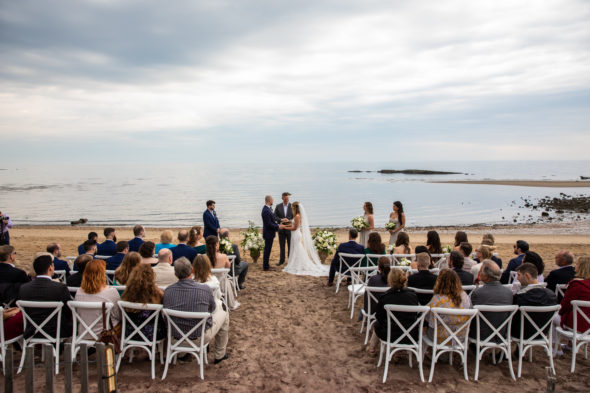
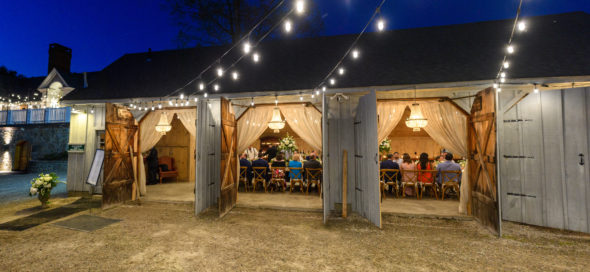
Photos by Robert Norman Photography
Hosting a Large Wedding
Everyone attends – Hosting a large wedding means everyone gets to celebrate this monumental moment with you and your partner! Everyone who has been a part of your life in some way, every member of your family and every friend, is a witness to your wedding. Being able to host everyone means a lesser chance of having to cut your guest list so dramatically to accommodate a small wedding.
Your day has room for more impact and grandeur – As your guest list grows, so does the space you need to host everyone. The space isn’t the only detail, as the number of tables and the potential for creative layouts increases, all lending to more memorable moments to all in attendance. Being able to expand upon your design allows your aesthetic and venue to hold more impact on everyone in attendance. Imagine an abundance of flowers draped across the room or chandeliers spread throughout the ceiling of your venue. Envision the 12-piece band that fills the space with their sound, causing everyone’s heart to skip a quick beat of excitement.
The Energy Scale is High – With more people and a fuller space, the energy is arguably higher than with a smaller-scale wedding. Arguably is the key word here, but it’s hard not to reach a certain momentum when you celebrate with 175+ people, thrilled to be in your presence and full of support, love, and joy.
Budget – Compared to a small wedding, large weddings require more diligence when preparing your budget. Because of the factors that adjust with your guest count, decisions should be periodically and carefully visited to maintain the budget you’ve set. With even an increase of 10 guests on your guest list, you can see your overall budget grow an additional $10,000. It’s that easy!
More guests = more opinions + dynamics to manage – One of our points above remains that with less guests, you can often avoid the overwhelming ideas and opinions that come with everyone who will be in attendance. More guests often invites more opinions, questions, and unsolicited advice. While the majority comes from a good place, it can land roughly and increase the stress that can be uncovered throughout planning.
With that, there are often certain dynamics that exist across family and friend groups. Let’s face it: weddings invite emotions, and mixed with alcohol, things commonly escalate.
Get a Load of our Large Weddings in our Galleries!
Lauren and Timmy’s wedding was one of our favorites. Our groom, Tim, is one of eleven children. His parents? One of eight each! Naturally, we had quite a celebration!

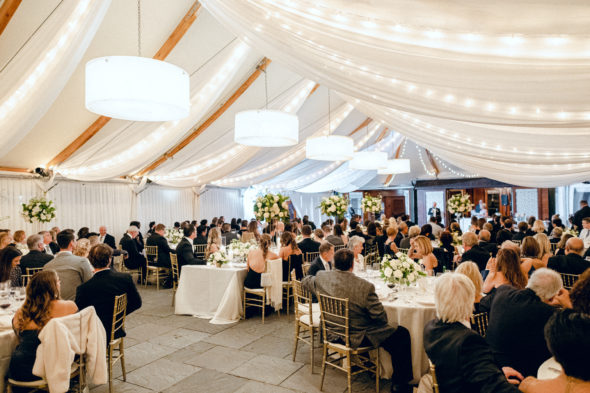
Photos by Melissa Stimpson Photography
The final thought we will leave you with is that we know configuring your guest list is no easy task. We know sometimes the decision is made for you by the size of your family alone. We know that splitting guests into an A, B, and even C list is just as daunting as building the overall guest list. We even understand that there are planning partners contributing to your overall budget, therefore guaranteeing their input to the guest list. Deciding on a small wedding or a large wedding sounds easier than it is. We hope the process is made easier with the considerations within this post!
[…] post, we talked about the considerations of hosting a large wedding and a small wedding. Check that blog post out here. As I wrote those tips for couples, I had Lauren and Tim’s Castle Hill Inn celebration in the […]